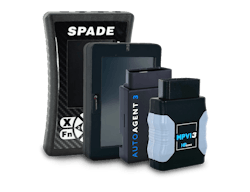In this article, you'll learn about:
- How shops and technicians can tell when a truck's been tampered with
- How to handle emissions systems legally
For more on emissions systems:
Emissions systems are not always the easiest truck component to work with, which can lead to ill-advised attempts to get rid of them, either out of frustration when things go wrong, or based on the fear of expensive repairs.
Using block-off plates, drilling holes in filter substrates, and completely ripping out components are common ways people physically delete emission systems. Please note that they are completely illegal and in no way encouraged by Fleet Maintenance. That said, it’s beneficial for professional, law-abiding fleets and shops to understand what’s still going on in the darkest corners of the industry—particularly shops that may see a truck come in that has been tampered with.
The trickier aspect to cheating lies within the vehicle’s software. As Jason Hedman, product manager at diagnostic tools and solutions provider Noregon, explained, there are a few different ways people do this—all of which are also illegal and not recommended:
- Emulator: A physical device is installed to mimic normal readings so the modules perceive the system as functioning correctly, even if it’s not.
- Tune: This is done with an aftermarket software used to “convince” the modules that all readings are within specification or that it should ignore those readings.
- Programmer/Tuner: An aftermarket device connects to the truck’s data link and manipulates readings to convey that the system is functioning normally.
According to Hedman, a really good technician can identify tampered vehicles. By using an advanced diagnostics tool like Noregon’s JPRO, a tech could observe the following indicators:
- Uniform DPF temperatures that do not fluctuate as the truck operates (e.g., consistent readings like 32 degrees F, irrespective of usage)
- Illogical temperature readings, such as a system temperature of 40 degrees F when the ambient air temperature is 80 degrees F
- Unnatural or stagnant fluctuations in aftertreatment system readings
One thing to keep in mind with tuning is that a lot of problems can be created if it isn’t done correctly. A tune can also be very difficult to undo, according to Bruce Balfour, vice president of Clean Diesel Specialists (CDS), a diesel emissions service and equipment company.
“First of all, you’ll have to replace everything that has been modified, right down to the sensors and entire DEF system,” Balfour said. “Then you have to try and untune the tune. This normally won’t work and all the modules that were programmed will have to be replaced. The cost of doing this can be as high as $50,000, if not more.”
“I’ve seen trucks that were tuned so far out of the realm that even the best technician couldn’t figure out what to do with it,” said Jacob Lopez, the service manager at Bullet Proof Diesel. “On the other hand, I’ve also seen trucks where DPFs and catalysts were gutted, but the owner didn’t have a way of tuning it. They were going for more horsepower, but ended up spending over $7,000 to replace parts they damaged so they could get the truck back out of limp mode. Their delete didn’t work out too well.”
Legal alternatives to deleting
Rather than run the risk of ruining a truck, there are smarter alternatives for fleets that still view emissions systems as the bane of their existence. According to Lopez, it starts with understanding what’s causing the aftertreatment issues to begin with.
“For the people who still want to delete, a lot of it is driven by past experience,” Lopez said. “Maybe they had a truck they had to spend a lot of money on, but the problem kept coming back. More often than not, that can be tied back to misdiagnosis, along with a lack of understanding of how an aftertreatment system actually works. Maybe the dealer or shop didn’t catch everything when that truck was in for service. They just treated a symptom, but not the root cause. Our shop likes to focus on finding the root cause so we can give the customer a lasting fix.”
Because many of his customers are driving heavy-duty pickups in stop-and-go traffic, Lopez said he also takes the time to educate them on what they can do to improve the performance of the aftertreatment system.
“We explain how that type of driving is hard on an aftertreatment system,” Lopez said. “We advise them to drive the truck a bit harder once in a while to try and get those temperatures up to passively cook off some of that soot. If they simply can’t avoid taking a lot of short trips, we recommend that they take a bit longer drive at the end of the day.”
Lopez said the Bullet Proof Diesel service shop also likes to follow an old-school diagnostic process. Some technicians love looking at sensor data. That’s important, but not the end-all.
“We like to check for things like a common boost leak in the air intake system, which can lead to more soot development that plugs up an EGR cooler or DPF,” Lopez said. “We also check for exhaust leaks, fuel injector condition, and overall signs of engine and aftertreatment system maintenance. That’s where you’ll often find the root causes of aftertreatment issues.”
Lopez said a lot of issues tie directly to the EGR cooler. Some coolers, even OE coolers on some trucks, are lacking in quality. Bullet Proof Diesel sells its own EGR coolers that Lopez said are heavier-duty and built for better flow. Simply switching to a higher-quality EGR cooler can make a lot of difference, Lopez said. Plus, it’s entirely legal.
Another thing to keep in mind is that some tuning is also entirely legal.
“Not all tuning is bad tuning,” pointed out Steve Hoke, president of Diesel Emissions Service (DES), a provider of parts and service. “With an electronically controlled engine, perfecting the injection timing is a good thing. I think fleets should have their own tuners for their own specific trucks, applications, and drivers. But the tuning is for fuel mileage, performance, and carbon atomization to keep their aftertreatment system working efficiently.”
After getting hit by the EPA, Calibrated Power Solutions is extremely careful to communicate the fact that its tuners are designed to help truck owners optimize truck performance while leaving emissions systems intact.
“Tuning a diesel engine is one of the most efficient things you can do with a vehicle,” Wilson said. “You can actually change the computer programming in the vehicle so it makes more power, but still puts out less soot and smoke than a factory calibration would. We focus on safely increasing horsepower, torque, and fuel economy—all while retaining all factory emissions equipment and safety settings in the truck. We’ve actually done comparison testing. The mileage gains from deleting vs. tuning the right way is less than a half-mile difference.”
That’s a pretty modest reward for a pretty monstrous risk. When you get down to it, there are right ways to go about improving vehicle performance and efficiency, and there are right ways to go about maintaining aftertreatment systems. When fleets focus on what’s right, they usually can’t go wrong.
About the Author

Gregg Wartgow
Gregg Wartgow is a freelancer who Fleet Maintenance has relied upon for many years, writing about virtually any trucking topic. He lives in Brodhead, Wisconsin.

